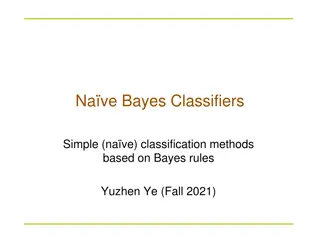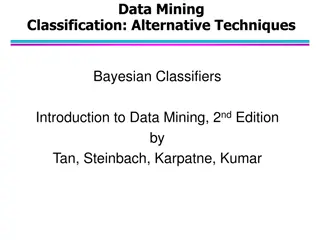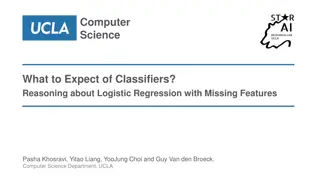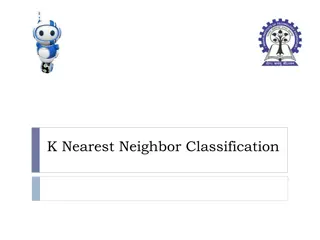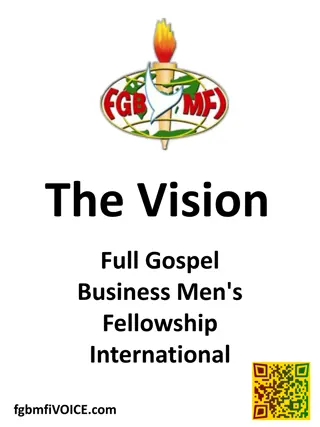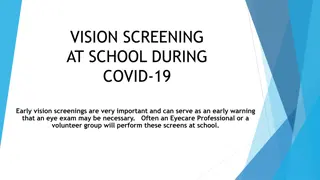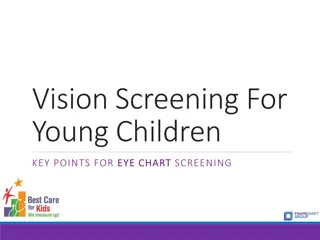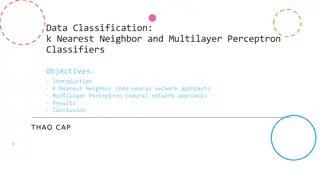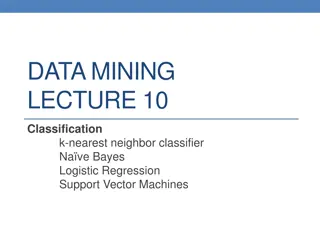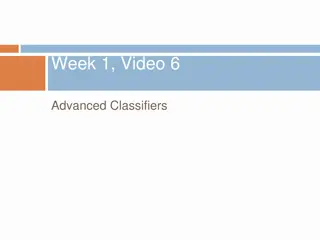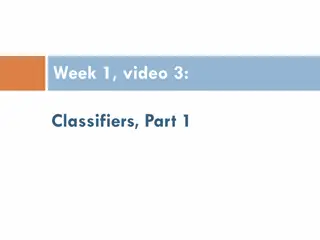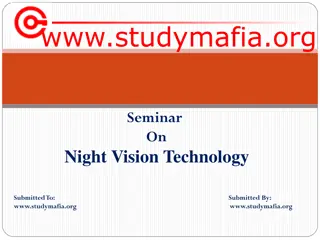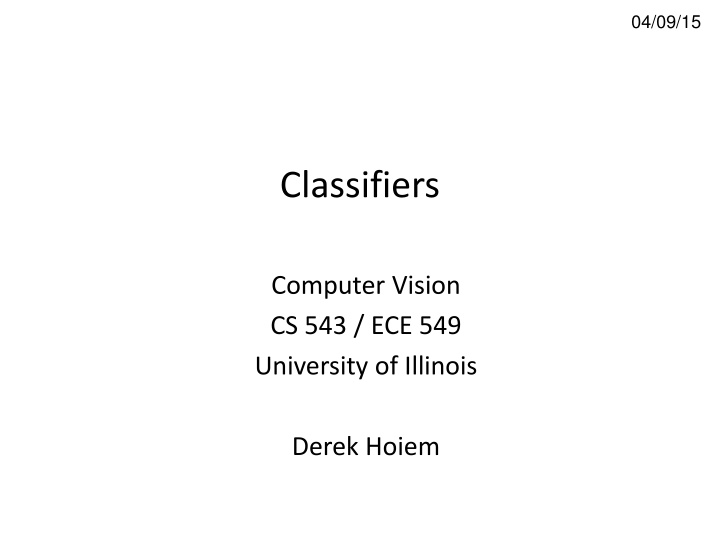
Image Categorization in Computer Vision
Explore the world of image categorization in computer vision, covering topics such as classifiers, training, features design, and types of classification methods. Delve into the importance of categorizing images, practical tips, and examples of categorization in various domains like object detection and emotion recognition.
Uploaded on | 0 Views
Download Presentation

Please find below an Image/Link to download the presentation.
The content on the website is provided AS IS for your information and personal use only. It may not be sold, licensed, or shared on other websites without obtaining consent from the author. If you encounter any issues during the download, it is possible that the publisher has removed the file from their server.
You are allowed to download the files provided on this website for personal or commercial use, subject to the condition that they are used lawfully. All files are the property of their respective owners.
The content on the website is provided AS IS for your information and personal use only. It may not be sold, licensed, or shared on other websites without obtaining consent from the author.
E N D
Presentation Transcript
04/09/15 Classifiers Computer Vision CS 543 / ECE 549 University of Illinois Derek Hoiem
Todays class Review of image categorization Classification A few examples of classifiers: nearest neighbor, generative classifiers, logistic regression, SVM Important concepts in machine learning Practical tips
What is a category? Why would we want to put an image in one? To predict, describe, interact. To organize. Many different ways to categorize
Examples of Categorization in Vision Part or object detection E.g., for each window: face or non-face? Scene categorization Indoor vs. outdoor, urban, forest, kitchen, etc. Action recognition Picking up vs. sitting down vs. standing Emotion recognition Region classification Label pixels into different object/surface categories Boundary classification Boundary vs. non-boundary Etc, etc.
Image Categorization Training Training Labels Training Images Image Features Classifier Training Trained Classifier
Image Categorization Training Training Labels Training Images Image Features Classifier Training Trained Classifier Testing Prediction Image Features Trained Classifier Outdoor Test Image
Feature design is paramount Most features can be thought of as templates, histograms (counts), or combinations Think about the right features for the problem Coverage Concision Directness
Classifier A classifier maps from the feature space to a label x x x x x x x o x o o o o x2 x1
Different types of classification Exemplar-based: transfer category labels from examples with most similar features What similarity function? What parameters? Linear classifier: confidence in positive label is a weighted sum of features What are the weights? Non-linear classifier: predictions based on more complex function of features What form does the classifier take? Parameters? Generative classifier: assign to the label that best explains the features (makes features most likely) What is the probability function and its parameters? Note: You can always fully design the classifier by hand, but usually this is too difficult. Typical solution: learn from training examples.
One way to think about it Training labels dictate that two examples are the same or different, in some sense Features and distance measures define visual similarity Goal of training is to learn feature weights or distance measures so that visual similarity predicts label similarity We want the simplest function that is confidently correct
Exemplar-based Models Transfer the label(s) of the most similar training examples
K-nearest neighbor classifier x x o x x x x + o x o x + o o o o x2 x1
1-nearest neighbor x x o x x x x + o x o x + o o o o x2 x1
3-nearest neighbor x x o x x x x + o x o x + o o o o x2 x1
5-nearest neighbor x x o x x x x + o x o x + o o o o x2 x1
Using K-NN Simple, a good one to try first Higher K gives smoother functions No training time (unless you want to learn a distance function) With infinite examples, 1-NN provably has error that is at most twice Bayes optimal error
Discriminative classifiers Learn a simple function of the input features that confidently predicts the true labels on the training set ? = ? ? Training Goals 1. Accurate classification of training data 2. Correct classifications are confident 3. Classification function is simple
Classifiers: Logistic Regression Objective Parameterization Regularization Training Inference x x x x x x x o x o o o o x2 x1 The objective function of most discriminative classifiers includes a loss term and a regularization term.
Using Logistic Regression Quick, simple classifier (good one to try first) Use L2 or L1 regularization L1 does feature selection and is robust to irrelevant features but slower to train
Classifiers: Linear SVM x x o x x x x x o x o o o o x2 x1
Classifiers: Kernelized SVM x x o o o x x x x x o o x2 o x x x
Using SVMs Good general purpose classifier Generalization depends on margin, so works well with many weak features No feature selection Usually requires some parameter tuning Choosing kernel Linear: fast training/testing start here RBF: related to neural networks, nearest neighbor Chi-squared, histogram intersection: good for histograms (but slower, esp. chi-squared) Can learn a kernel function
Classifiers: Decision Trees x x o x x x x o x o x o o o o x2 x1
Ensemble Methods: Boosting figure from Friedman et al. 2000
Boosted Decision Trees High in Image? Gray? Yes No Yes No High in Image? Many Long Lines? Smooth? Green? Yes Yes No Yes No Yes No No Very High Vanishing Point? Blue? Yes No Yes No P(label | good segment, data) Ground Vertical Sky [Collins et al. 2002]
Using Boosted Decision Trees Flexible: can deal with both continuous and categorical variables How to control bias/variance trade-off Size of trees Number of trees Boosting trees often works best with a small number of well-designed features Boosting stubs can give a fast classifier
Generative classifiers Model the joint probability of the features and the labels Allows direct control of independence assumptions Can incorporate priors Often simple to train (depending on the model) Examples Na ve Bayes Mixture of Gaussians for each class
Nave Bayes Objective Parameterization Regularization Training Inference y x1 x2 x3
Using Nave Bayes Simple thing to try for categorical data Very fast to train/test
Clustering (unsupervised) + x + o + + x x + x + + x + + o x x + o + o + o x2 x2 x1 x1
Many classifiers to choose from SVM Neural networks Na ve Bayes Bayesian network Logistic regression Randomized Forests Boosted Decision Trees K-nearest neighbor RBMs Deep networks Etc. Which is the best one?
Generalization Theory It s not enough to do well on the training set: we want to also make good predictions for new examples
Bias-Variance Trade-off E(MSE) = noise2 + bias2 + variance Error due to variance parameter estimates from training samples Unavoidable error Error due to incorrect assumptions See the following for explanation of bias-variance (also Bishop s Neural Networks book): http://www.inf.ed.ac.uk/teaching/courses/mlsc/Notes/Lecture4/BiasVariance.pdf
Bias and Variance Error = noise2 + bias2 + variance Few training examples Test Error Many training examples High Bias Low Variance Low Bias High Variance Complexity
Choosing the trade-off Need validation set Validation set is separate from the test set Test error Error Training error High Bias Low Variance Low Bias High Variance Complexity
Effect of Training Size Fixed classifier Error Testing Generalization Error Training Number of Training Examples
How to measure complexity? VC dimension What is the VC dimension of a linear classifier for N- dimensional features? For a nearest neighbor classifier? Upper bound on generalization error Test error <= Training error + N: size of training set h: VC dimension : 1-probability that bound holds Other ways: number of parameters, etc.
How to reduce variance? Choose a simpler classifier Regularize the parameters Use fewer features Get more training data Which of these could actually lead to greater error?
Reducing Risk of Error Margins x x x x x x x o x o o o o x2 x1
The perfect classification algorithm Objective function: encodes the right loss for the problem Parameterization: makes assumptions that fit the problem Regularization: right level of regularization for amount of training data Training algorithm: can find parameters that maximize objective on training set Inference algorithm: can solve for objective function in evaluation
Comparison assuming x in {0 1} Learning Objective Training Inference ( ) P T T + ( ) x x 1 0 x ( ) 1 0 ( ( ) ) 1 = = + 1 x y k r log | ; P x y | 1 = = 1 y Na ve Bayes ij i ij i j j = where log , maximize = 1 j = = i | 1 = 0 P x y j ( ) Kr + j ( ) kj ( ( ) = y k + log ; P y = | 0 P x y i i j = log 0 i ) 0 0 j = = i | 0 P x y j ( ( ) ) + x maximize log | , P y Logistic Regression i T x t Gradient ascent i ( ( ) ) ( ) = + T x x where | , / 1 1 exp P y y i i 1 i y + minimize Quadratic programming or subgradient opt. Linear SVM i 2 T x t T x such that 1 , 0 i i i i Kernelized SVM ( ) i Quadratic programming x x , 0 y K complicated to write i i i y Nearest Neighbor i ( ) most similar features same label Record data = x , x where argmin i i K i
Characteristics of vision learning problems Lots of continuous features E.g., HOG template may have 1000 features Spatial pyramid may have ~15,000 features Imbalanced classes often limited positive examples, practically infinite negative examples Difficult prediction tasks
When a massive training set is available Relatively new phenomenon MNIST (handwritten letters) in 1990s, LabelMe in 2000s, ImageNet (object images) in 2009, Want classifiers with low bias (high variance ok) and reasonably efficient training Very complex classifiers with simple features are often effective Random forests Deep convolutional networks
New training setup with moderate sized datasets Training Labels Training Images Tune CNN features and Neural Network classifier Trained Classifier Initialize CNN Features Dataset similar to task with millions of labeled examples
Practical tips Preparing features for linear classifiers Often helps to make zero-mean, unit-dev For non-ordinal features, convert to a set of binary features Selecting classifier meta-parameters (e.g., regularization weight) Cross-validation: split data into subsets; train on all but one subset, test on remaining; repeat holding out each subset Leave-one-out, 5-fold, etc. Most popular classifiers in vision SVM: linear for when fast training/classification is needed; performs well with lots of weak features Logistic Regression: outputs a probability; easy to train and apply Nearest neighbor: hard to beat if there is tons of data (e.g., character recognition) Boosted stumps or decision trees: applies to flexible features, incorporates feature selection, powerful classifiers Random forests: outputs probability; good for simple features, tons of data Deep networks / CNNs: flexible output; learns features; adapt existing network (which is trained with tons of data) or train new with tons of data Always try at least two types of classifiers
What to remember about classifiers No free lunch: machine learning algorithms are tools Try simple classifiers first Better to have smart features and simple classifiers than simple features and smart classifiers Though with enough data, smart features can be learned Use increasingly powerful classifiers with more training data (bias-variance tradeoff)
Some Machine Learning References General Tom Mitchell, Machine Learning, McGraw Hill, 1997 Christopher Bishop, Neural Networks for Pattern Recognition, Oxford University Press, 1995 Adaboost Friedman, Hastie, and Tibshirani, Additive logistic regression: a statistical view of boosting , Annals of Statistics, 2000 SVMs http://www.support-vector.net/icml-tutorial.pdf Random forests http://research.microsoft.com/pubs/155552/decisionForests_MSR_TR _2011_114.pdf
Next class Detection using sliding windows and region proposals


